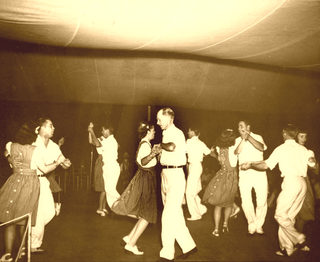
A square dance is a dance for four couples, or eight dancers in total, arranged in a square, with one couple on each side, facing the middle of the square. Square dances are part of a broad spectrum of dances known by various names: country dances, traditional dances, folk dances, barn dances, ceilidh dances, contra dances, Playford dances, etc. These dances appear in over 100 different formations, of which the Square and the Longways Set are by far the most popular formations.
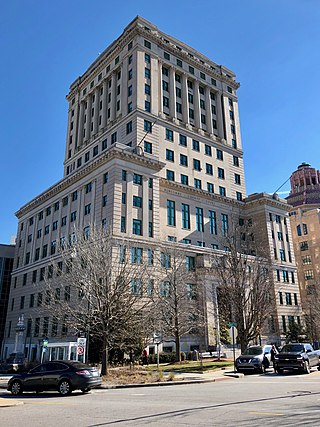
Buncombe County is a county located in the U.S. state of North Carolina. It is classified within Western North Carolina. The 2020 census reported the population was 269,452, making it the 7th-most populous county in North Carolina. Its county seat is Asheville. Buncombe County is part of the Asheville, NC Metropolitan Statistical Area.

Asheville is a city in and the county seat of Buncombe County, North Carolina, United States. Located at the confluence of the French Broad and Swannanoa rivers, it is the most populous city in Western North Carolina, and the state's 11th-most-populous city. According to the 2020 census, the city's population was 94,589, up from 83,393 in the 2010 census. It is the principal city in the four-county Asheville metropolitan area, which had an estimated population of 417,202 in 2023.
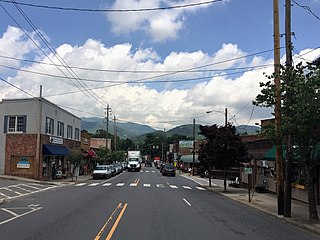
Black Mountain is a town in Buncombe County, North Carolina, United States. The population was 8,426 at the 2020 United States census. It is part of the Asheville Metropolitan Statistical Area. The town is named for the old train stop at the Black Mountain Depot and is located at the southern end of the Black Mountain range of the Blue Ridge Mountains in the Southern Appalachians.

Morganton is a city in and county seat of Burke County, North Carolina, United States. The population was 17,474 at the 2020 census. Morganton is approximately 75 miles (121 km) northwest of Charlotte and 57 miles (92 km) east of Asheville.

Old-time music is a genre of North American folk music. It developed along with various North American folk dances, such as square dancing, contra dance, clogging, and buck dancing. It is played on acoustic instruments, generally centering on a combination of fiddle and plucked string instruments, most often the banjo, guitar, and mandolin. Together, they form an ensemble called the string band, which along with the simple banjo–fiddle duet have historically been the most common configurations to play old-time music. The genre is considered a precursor to modern country music.

The French Broad River is a river in the U.S. states of North Carolina and Tennessee. It flows 218 miles (351 km) from near the town of Rosman in Transylvania County, North Carolina, into Tennessee, where its confluence with the Holston River at Knoxville forms the beginning of the Tennessee River. The river flows through the counties of Transylvania, Buncombe, Henderson, and Madison in North Carolina, and Cocke, Jefferson, Sevier, and Knox in Tennessee. It drains large portions of the Pisgah National Forest and the Cherokee National Forest.
Clogging, buck dancing, or flatfoot dancing is a type of folk dance practiced in the United States, in which the dancer's footwear is used percussively by striking the heel, the toe, or both against a floor or each other to create audible rhythms, usually to the downbeat with the heel keeping the rhythm. Clogging can be found at various Old-Time and Bluegrass Music festivals.

Bascom Lamar Lunsford was a folklorist, performer of traditional Appalachian music, and lawyer from western North Carolina. He was often known by the nickname "Minstrel of the Appalachians."

Traditional square dance is a generic American term for any style of American square dance other than modern Western. The term can mean (1) any of the American regional styles that existed before around 1950, when modern Western style began to develop out of a blend of those regional styles, or (2) any style that has survived, or been revived, since around 1950. The term Traditional Square Dance is also used in England to refer to dances collected from villages in the first half of the 20th century.
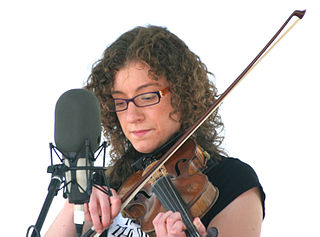
Rayna Gellert is an American fiddler, acoustic guitarist, singer, and songwriter specializing in old-time music.
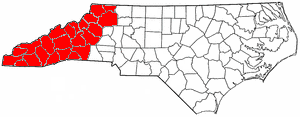
Western North Carolina is the region of North Carolina which includes the Appalachian Mountains; it is often known geographically as the state's Mountain Region. It contains the highest mountains in the Eastern United States, with 125 peaks rising to over 5,000 feet in elevation. Mount Mitchell at 6,684 feet, is the highest peak of the Appalachian Mountains and mainland eastern North America. The population of the 23 most commonly associated counties for the region, as measured by the 2020 U.S. Census, is 1,149,405. The region accounts for approximately 11% of North Carolina's total population.
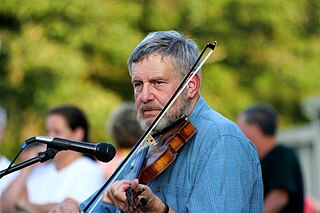
Bob Dalsemer is a square and contra dance writer and caller. He has called dances for more than 50 years and in more than 33 states, plus internationally in Canada, the Czech Republic, Britain, Belgium, Denmark and Russia. He began writing dances in the mid-1970s. He wrote the book West Virginia Square Dances and Folk Dance Fun for Schools and Families. He has also compiled the cassette/book compilations Smoke On the Water: Square Dance Classics and When The Work's All Done: A Square Dance Party For Beginners and Old Hands.
Wilma Dykeman Stokely was an American writer of fiction and nonfiction whose works chronicled the people and land of Appalachia.
Billy Edward Wheeler was an American songwriter, performer, writer, and visual artist.

Sheila Kay Adams is an American storyteller, author, and musician from the Sodom Laurel community in Madison County, North Carolina.
Al Petteway was an American guitarist known primarily for his acoustic fingerstyle work both as a soloist and with well-known folk artists such as Amy White, Tom Paxton, Jethro Burns, Jonathan Edwards, Cheryl Wheeler, Debi Smith, Bonnie Rideout, Maggie Sansone and many others. His own compositions rely heavily on Celtic and Appalachian influences and he is known for his use of DADGAD tuning.

Ira Bernstein is a dancer and teacher in the United States who specializes in traditional American dance forms such as Appalachian-style clogging, flatfoot dancing, tap dance, and step dancing. He is considered an authority on clogging, and the leading figure in this dance style. He calls himself a "percussive step dancer who specializes in Appalachian flatfooting," and also dances Green Grass style Appalachian clogging, English clogging, French-Canadian step dancing, Irish step dancing, and South African gumboot dancing.
The following is a timeline of the history of the city of Asheville, North Carolina, USA.
Carroll Best was an American bluegrass banjo player and music educator. He was briefly a member of The Morris Brothers in the mid 1950s. He was the winner of several regional banjo contests before being awarded the widely recognized Bascom Lamar Lunsford Award in 1990. He is credited for developing an influential melodic three-finger banjo style, which he taught as a member of the faculty at the Tennessee Banjo Institute. This style influenced the work of musicians Tony Trischka and Bela Fleck. His work was featured on radio broadcasts for NPR and The Grand Ole Opry, and on the television program Hee Haw. He released two albums while he was alive, and a third album of his work was released posthumously in 2001. He is listed as a historic artist by the Blue Ridge National Heritage Area, and was given the North Carolina Heritage Award in 1994.














